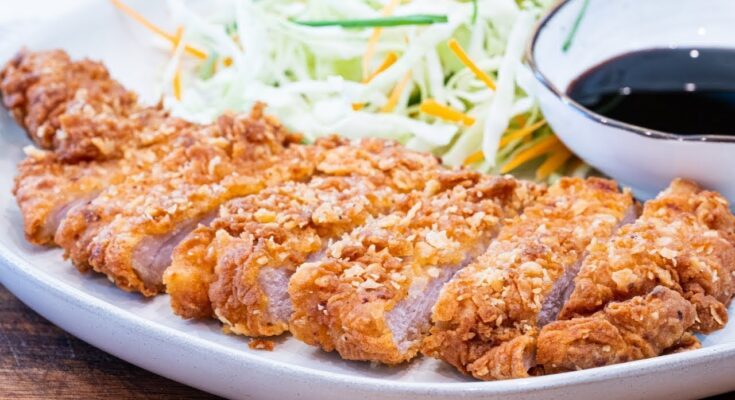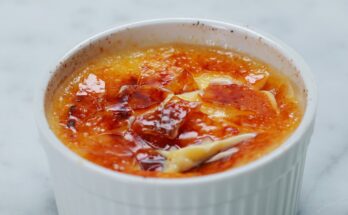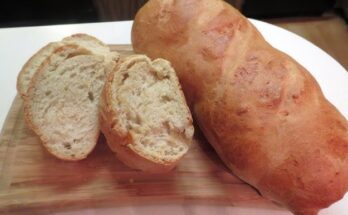Breaded Pork Chops Recipe: Breaded pork chops are one of those dishes that never go out of style. They are crispy on the outside, juicy on the inside, and packed with flavor in every bite. Whether you grew up eating them at family dinners or discovered them later as a quick and satisfying meal, there’s no denying their appeal. They bring together the best of comfort food—warmth, crunch, and a delicious savory taste that satisfies both kids and adults.
So, whether you’re a beginner in the kitchen or someone who enjoys experimenting with flavors, this recipe is for you. We’ll walk you through everything—from choosing the right cut of pork to breading, cooking, and serving them perfectly.
By the end of this guide, you’ll have a foolproof method for making breaded pork chops that turn out golden, crispy, and tender every single time.
Ingredients You’ll Need
The beauty of breaded pork chops lies in their simplicity. Most of the ingredients are basic staples you probably already have in your kitchen. However, the secret to great flavor lies in seasoning them correctly and layering flavors at each stage of preparation. Let’s break it down:
Essential Ingredients:
- Pork chops (bone-in or boneless) – Choose about 1-inch-thick chops for the best balance of crispiness and tenderness.
- All-purpose flour – This is the first coating layer, which helps the egg stick to the pork.
- Eggs – Beaten eggs act as the binding agent that helps the breadcrumbs stick.
- Breadcrumbs – Plain or seasoned breadcrumbs will give your pork chops that signature crispy texture.
- Salt and black pepper – For seasoning and balancing the flavors.
- Cooking oil (vegetable, canola, or olive oil) – Needed for frying or lightly greasing if you bake them.
Optional Flavor Boosters:
- Garlic powder or onion powder – Adds a deeper savory taste.
- Paprika or cayenne pepper – For a smoky or spicy kick.
- Parmesan cheese (grated) – Mixing this with breadcrumbs adds a nutty, cheesy crust.
- Herbs like parsley, thyme, or oregano – Fresh or dried herbs can elevate the flavor beautifully.
Substitute Ideas:
- Instead of all-purpose flour, you can use almond flour for a low-carb version.
- Replace regular breadcrumbs with panko for extra crunch.
- Swap eggs with buttermilk if you want a tangier flavor and softer coating.
When it comes to ingredients, the key is to balance flavor and texture. The flour ensures the breading sticks, the egg wash binds everything together, and the breadcrumbs provide that irresistible crunch. With a few optional tweaks, you can make this dish your own by adding a hint of spice, cheese, or herbs.
Kitchen Tools and Equipment Required
Making breaded pork chops doesn’t require a fancy kitchen setup. In fact, with just a few basic tools, you’ll be able to whip them up with ease. Still, having the right equipment can make the process smoother and more enjoyable.
Basic Tools You’ll Need:
- Cutting board and sharp knife – For trimming fat and prepping the pork chops.
- Mixing bowls – At least three bowls: one for flour, one for beaten eggs, and one for breadcrumbs.
- Tongs – Essential for handling pork chops without messing up the breading.
- Skillet or frying pan – A heavy-bottomed skillet (like cast iron) is perfect for frying as it retains heat evenly.
- Baking sheet with wire rack – If you prefer baking, this setup helps airflow and keeps the coating crispy.
Must-Have Cookware:
- Meat thermometer – To check if the pork is cooked through without cutting into it. Pork chops are safe at 145°F (63°C).
- Paper towels – For draining excess oil after frying.
- Whisk – To beat the eggs and ensure a smooth coating mixture.
Optional Tools for Convenience:
- Food processor – If you want to make your own breadcrumbs.
- Mallet – For pounding chops to even thickness, ensuring they cook evenly.
- Oil sprayer – Useful for lightly coating chops when baking instead of frying.
Having these tools handy ensures that your pork chops cook evenly, stay crispy, and come out looking like they were made in a professional kitchen. It also makes cleanup much easier when you’re done.
Preparing the Pork Chops
Preparation is everything when it comes to making the perfect breaded pork chops. Before you even think about dipping them in flour and breadcrumbs, it’s important to choose the right cut and prep them properly.
Choosing the Right Cut:
- Bone-in pork chops – These tend to be juicier and more flavorful because the bone helps retain moisture during cooking.
- Boneless pork chops – Easier to eat and quicker to cook, but they can dry out faster if not handled carefully.
For breaded pork chops, bone-in is often preferred, but either works depending on your preference.
Trimming and Preparing:
Start by trimming any excess fat around the edges. Too much fat can cause splattering when frying. If your chops are very thick, consider pounding them lightly with a meat mallet to about ¾ to 1 inch thickness for even cooking.
Marinating for Extra Flavor:
While not necessary, marinating pork chops before breading can take the flavor to the next level. A simple marinade could include:
- Olive oil
- Garlic
- Lemon juice
- Herbs (like thyme or rosemary)
Marinate for 30 minutes to 2 hours for best results. This not only adds flavor but also tenderizes the meat slightly, ensuring a juicy bite.
Taking the time to prepare your pork chops correctly sets the stage for success. Well-trimmed, properly seasoned, and evenly cut pork chops make the breading process smoother and the final dish more delicious.
Step-by-Step Guide to Making Breaded Pork Chops
This is where the magic happens. Breading pork chops is all about layering textures and locking in flavor. Follow these steps carefully for perfect results every time:
Step 1: Setting Up the Breading Station
You’ll need three shallow bowls or plates:
- Flour mixture – Mix flour with a pinch of salt and pepper.
- Egg wash – Beat a couple of eggs until smooth.
- Breadcrumbs mixture – Use plain or seasoned breadcrumbs, and feel free to mix in herbs, spices, or Parmesan cheese.
Line them up in order so you can move easily from one to the next.
Step 2: Coating Pork Chops Properly
- Dredge each pork chop in flour, shaking off any excess.
- Dip it into the egg wash until fully coated.
- Press it into the breadcrumbs mixture, ensuring both sides are covered.
Tip: Press the breadcrumbs firmly so they stick well and don’t fall off while cooking.
Step 3: Pan-Frying or Baking
- Pan-frying: Heat oil in a skillet over medium heat. Cook each chop for 4–5 minutes per side until golden brown.
- Baking: Preheat the oven to 400°F (200°C). Place breaded chops on a greased baking sheet or wire rack and bake for 20–25 minutes.
Step 4: Achieving the Perfect Golden Crust
Don’t overcrowd the pan or baking sheet—this allows heat to circulate properly. For frying, ensure the oil is hot enough before adding the chops. If it’s too cold, the breading will absorb oil and become soggy.
Step 5: Resting and Serving
Once cooked, let the pork chops rest for 5 minutes before serving. This helps the juices redistribute, making each bite tender and flavorful.
Serve with mashed potatoes, roasted vegetables, or a fresh salad for a complete meal.
Tips for Perfectly Crispy Breaded Pork Chops
One of the most common frustrations when making breaded pork chops is ending up with a soggy crust instead of that perfect golden crunch. Luckily, there are a few simple tricks you can use to ensure success every time.
First, make sure your pork chops are completely dry before breading. Pat them with paper towels to remove excess moisture. Wet pork will prevent the flour and egg wash from sticking properly, which leads to uneven breading. Another key factor is pressing the breadcrumbs firmly into the pork chops. Don’t just coat them lightly—give them a gentle press to help the crust adhere better.
Temperature control is another game-changer. If you’re pan-frying, ensure your oil is hot enough before adding the pork chops. Ideally, the oil should be around 350°F (175°C). Too cold, and the coating absorbs oil, becoming greasy. Too hot, and the breading burns before the inside cooks. For baking, placing the pork chops on a wire rack instead of directly on the baking sheet ensures heat circulates all around, keeping the bottom crispy instead of soggy.
Finally, avoid flipping the chops too many times. Let one side cook fully before turning, so the breading stays intact. And remember—after cooking, always let your pork chops rest for a few minutes. This small step prevents juices from escaping, keeping the meat tender and the coating crunchy.
Different Cooking Methods for Breaded Pork Chops
Breaded pork chops are incredibly versatile, and how you cook them can make a big difference in taste and texture. Each method has its pros and cons, so let’s explore the main options:
1. Pan-Frying:
This is the classic method and produces the crispiest results. Using a heavy-bottomed skillet with about ¼ inch of oil, you’ll fry the chops for a few minutes on each side until golden brown. The key is not to overcrowd the pan and to maintain steady heat. The downside is that it requires more oil and can be a bit messy, but the flavor is unbeatable.
2. Oven-Baking:
If you want a healthier option, baking is the way to go. Preheat the oven to 400°F (200°C) and place your breaded chops on a wire rack set over a baking sheet. This keeps them elevated and allows hot air to circulate. Bake for 20–25 minutes, flipping halfway through if needed. Baking requires less oil and cleanup, but the crust won’t be quite as crunchy as frying.
3. Air Frying:
Air fryers have become a favorite for breaded pork chops. Set your air fryer to 375°F (190°C) and cook for about 12–15 minutes, flipping halfway. You get crispy chops with very little oil, and it’s quick and convenient. This method gives you the best of both worlds—crispy texture without the extra calories from frying.
4. Grilling (with a twist):
While not traditional, you can grill breaded pork chops if you first sear them in a pan to set the crust. Then, transfer them to indirect heat on the grill to finish cooking. This method adds a smoky flavor but requires more attention to prevent the breading from burning.
Each method has its charm. Pan-frying delivers indulgent crispiness, baking is healthier, air frying is convenient, and grilling adds unique smoky notes. Choose the one that suits your lifestyle and kitchen setup.
Serving Suggestions and Side Dishes
Breaded pork chops are delicious on their own, but they truly shine when paired with the right sides. Depending on the occasion, you can keep things simple or go all out with a full spread.
Classic Comfort Pairings:
- Mashed potatoes and gravy – The creamy potatoes balance the crunchy pork perfectly.
- Green beans or steamed broccoli – Adds a healthy, fresh contrast.
- Corn on the cob – Sweet and buttery, a perfect complement.
Light and Fresh Options:
- Garden salad with vinaigrette – Keeps the meal refreshing and balanced.
- Roasted vegetables – Carrots, zucchini, or asparagus roasted with olive oil and herbs.
- Cauliflower rice – A low-carb option that still feels satisfying.
Creative Twists:
- Breaded pork chop sandwich – Place the chop in a bun with lettuce, tomato, and mayo.
- Pork chop Parmesan – Top with marinara sauce and mozzarella cheese, then bake for a delicious Italian twist.
- Asian-style rice bowls – Serve sliced pork chops over jasmine rice with soy sauce and stir-fried veggies.
For beverages, you can’t go wrong with a cold iced tea, a crisp white wine, or even a light beer to balance the richness. And don’t forget dessert—apple pie or peach cobbler pairs beautifully with this hearty meal.
Storage and Reheating Instructions
Leftovers are a blessing when it comes to breaded pork chops, but only if you store and reheat them correctly. Done wrong, they’ll lose their crunch and turn rubbery.
Storing:
- Let pork chops cool completely before storing.
- Place them in an airtight container lined with paper towels to absorb excess moisture.
- Store in the refrigerator for up to 3–4 days.
For longer storage, you can freeze them:
- Wrap each pork chop individually in plastic wrap or foil.
- Place in a freezer-safe bag or container.
- Freeze for up to 2 months.
Reheating:
- Oven method (best for crispiness): Preheat oven to 350°F (175°C). Place pork chops on a wire rack over a baking sheet and bake for 10–15 minutes.
- Air fryer method: Heat at 350°F (175°C) for 5–7 minutes until warm and crispy.
- Microwave (not recommended): While fast, this method makes breading soggy. Use only if in a rush.
The oven or air fryer methods will restore that crunchy coating while keeping the inside tender. If frozen, thaw in the refrigerator overnight before reheating.
Variations of Breaded Pork Chops
One of the best things about breaded pork chops is how easily you can adapt the recipe to your taste preferences. A few simple changes can create an entirely new flavor profile.
Flavor Variations:
- Italian-style: Mix Parmesan cheese, oregano, and basil into the breadcrumbs. Serve with marinara sauce.
- Southern-style: Add cayenne pepper, paprika, and garlic powder for a spicy kick. Serve with cornbread and collard greens.
- Asian-style: Use panko breadcrumbs, soy sauce in the egg wash, and sesame seeds in the coating. Serve with fried rice.
Texture Variations:
- Extra crispy: Double-dip the pork chops by repeating the egg wash and breadcrumb steps for a thicker crust.
- Gluten-free: Swap flour for cornstarch and breadcrumbs for crushed rice crackers.
- Low-carb/Keto-friendly: Replace breadcrumbs with almond flour or crushed pork rinds.
Cooking Variations:
- Stuffed breaded pork chops: Cut a pocket into the pork chop and fill with cheese, spinach, or mushrooms before breading.
- Pork schnitzel style: Pound pork chops very thin, bread, and fry quickly for a German-inspired twist.
These variations keep the recipe exciting and ensure you’ll never get bored of breaded pork chops.
Nutritional Value of Breaded Pork Chops
Breaded pork chops are undeniably tasty, but many people wonder how they fit into a balanced diet. The good news is, when prepared correctly, they can be both satisfying and relatively nutritious. Let’s break down the nutritional profile.
A standard breaded pork chop (around 6 ounces, pan-fried) contains:
- Calories: 350–400
- Protein: 25–30g
- Fat: 15–20g
- Carbohydrates: 15–20g (from flour and breadcrumbs)
- Fiber: 1–2g (depending on breadcrumb type)
- Vitamins & Minerals: Pork is an excellent source of B vitamins (B6 and B12), zinc, iron, and selenium.
The protein content makes breaded pork chops a hearty, muscle-friendly meal. They also provide essential nutrients for energy and immunity. However, the calorie and fat content largely depend on your cooking method. Pan-frying in oil adds more calories than baking or air frying.
For a lighter version, try these swaps:
- Use whole-wheat or panko breadcrumbs for added fiber and crunch.
- Opt for baking or air frying instead of deep frying.
- Trim excess fat before cooking to reduce overall fat content.
- Serve with vegetable sides instead of starchy options to balance the meal.
Ultimately, breaded pork chops can be part of a balanced diet when enjoyed in moderation and paired with wholesome sides.
Common Mistakes to Avoid When Making Breaded Pork Chops
Even a simple recipe like breaded pork chops can go wrong if you skip small details. Here are the most common mistakes and how to avoid them:
- Skipping the drying step – If your pork chops are wet, the breading won’t stick properly. Always pat them dry before starting.
- Not seasoning enough – Season every layer: flour, egg wash, and breadcrumbs. This ensures the flavor runs through every bite.
- Using too thin or too thick chops – Very thin chops dry out quickly, while overly thick ones may not cook evenly. Aim for about ¾ to 1 inch thick.
- Overcrowding the pan – This lowers the oil temperature, causing soggy breading. Fry in batches if necessary.
- Flipping too often – Constantly flipping breaks the crust. Cook one side fully before turning once.
- Cooking on high heat – While you want hot oil, too much heat burns the crust before the meat cooks. Medium heat works best.
- Skipping the resting time – Cutting into pork chops right after cooking lets the juices escape. Resting ensures a juicier bite.
Avoiding these mistakes will give you restaurant-quality pork chops at home every single time.
History and Cultural Significance of Breaded Pork Chops
Breaded pork chops may feel like a modern comfort food, but they have deep roots in culinary history. The idea of breading and frying meat goes back centuries, with variations appearing across many cultures.
In Europe, dishes like schnitzel from Germany and Austria feature breaded, fried pork or veal. In Italy, cotoletta alla Milanese is a classic breaded cutlet served with lemon wedges. These traditions influenced how breaded pork chops became popular in the United States, especially in immigrant communities.
In the American South, breaded pork chops became a staple due to their affordability and heartiness. Families often coated pork in cornmeal or seasoned flour, frying it in cast iron skillets. This rustic approach gave rise to comfort food traditions still cherished today.
Globally, breaded pork dishes continue to adapt to local flavors. In Japan, tonkatsu is a beloved breaded pork cutlet served with shredded cabbage and tangy sauce. Each culture puts its own spin on the dish, proving that breaded pork chops are more than just a recipe—they’re a shared love for crispy, flavorful comfort food.
Breaded Pork Chops vs. Other Pork Chop Recipes
Pork chops are versatile, and breaded ones are just one of many delicious ways to enjoy them. Here’s how they compare with other popular styles:
| Recipe Type | Texture & Flavor | Cooking Method | Key Difference |
|---|---|---|---|
| Breaded Pork Chops | Crispy outside, juicy inside | Fried, baked, or air fried | Crunchy coating from breadcrumbs |
| Grilled Pork Chops | Smoky, slightly charred | Grilled over open flame | No breading, relies on marinades |
| Smothered Pork Chops | Tender, saucy, rich flavor | Pan-fried then simmered | Covered in gravy |
| Stuffed Pork Chops | Juicy with flavorful filling | Baked or roasted | Filled with cheese, veggies, or herbs |
| Slow-Cooked Pork Chops | Fall-apart tender, deeply seasoned | Crockpot or slow cooker | Long, slow cooking in broth or sauce |
Breaded pork chops stand out for their satisfying crunch, which you won’t find in other pork chop styles. However, each method brings something unique to the table. For example, grilled pork chops are lighter and smoky, while smothered ones feel indulgent and comforting.
Why This Recipe is Perfect for Beginners
If you’re new to cooking, breaded pork chops are a fantastic place to start. The recipe is simple, requires only a handful of common ingredients, and doesn’t demand advanced cooking skills. You’ll learn useful kitchen basics like breading, frying, and temperature control—all while making a dish that looks and tastes impressive.
The step-by-step process also builds confidence. By setting up a breading station, you practice organization and prep work. Frying teaches you how to monitor heat, and baking shows you how to use your oven effectively. The reward? A plate of golden, crispy pork chops that taste like they came from a restaurant.
Another reason this recipe is beginner-friendly is its flexibility. If frying feels intimidating, you can bake or air fry instead. If you make a mistake (like uneven breading), the chops will still taste delicious. It’s forgiving, approachable, and a skill you can master quickly.
Most importantly, breaded pork chops are a crowd-pleaser. Whether you’re cooking for your family, friends, or just yourself, you’ll feel proud serving a dish that always earns compliments.
FAQs about Breaded Pork Chops Recipe
1. Can I make breaded pork chops ahead of time?
Yes! You can bread the pork chops a few hours in advance and refrigerate them until you’re ready to cook. Just cover them lightly with plastic wrap. This helps the breading stick better and saves time during busy evenings.
2. How do I keep breading from falling off during cooking?
The trick is to pat the pork chops dry before breading, press the breadcrumbs firmly onto the meat, and avoid flipping too often. Resting the breaded chops for 10–15 minutes before cooking also helps set the coating.
3. What type of breadcrumbs work best?
Panko breadcrumbs give you a light, extra-crispy coating, while traditional breadcrumbs offer a finer, more uniform crust. You can even mix the two for the best of both worlds.
4. How do I know when pork chops are cooked through?
Use a meat thermometer for accuracy. Pork chops are safe to eat when they reach an internal temperature of 145°F (63°C). Let them rest for a few minutes after cooking to lock in juices.
5. Can I make breaded pork chops without eggs?
Absolutely. Instead of eggs, you can use buttermilk, plain yogurt, or even mayonnaise as a binder. These alternatives help the breadcrumbs stick and add unique flavor to the dish.
Conclusion
We’ve covered everything you need to know: the right ingredients, essential kitchen tools, step-by-step instructions, common mistakes to avoid, and even creative variations. Whether you pan-fry, bake, or air fry, this recipe adapts to your lifestyle and taste preferences. You can enjoy it as a classic homestyle dinner with mashed potatoes or reinvent it into something new, like pork Parmesan or an Asian-inspired rice bowl.
Beyond just being delicious, breaded pork chops carry cultural significance. From European schnitzel to Japanese tonkatsu and Southern-style pork cutlets, this dish connects food traditions around the world. It’s not just a meal—it’s a culinary bridge between cultures.
If you’re a beginner, this recipe is the perfect confidence booster. If you’re experienced, it’s a canvas for creativity. Either way, breaded pork chops are sure to remain a staple in your kitchen. So, gather your ingredients, follow the steps, and get ready to enjoy one of the most satisfying meals you can make at home.



